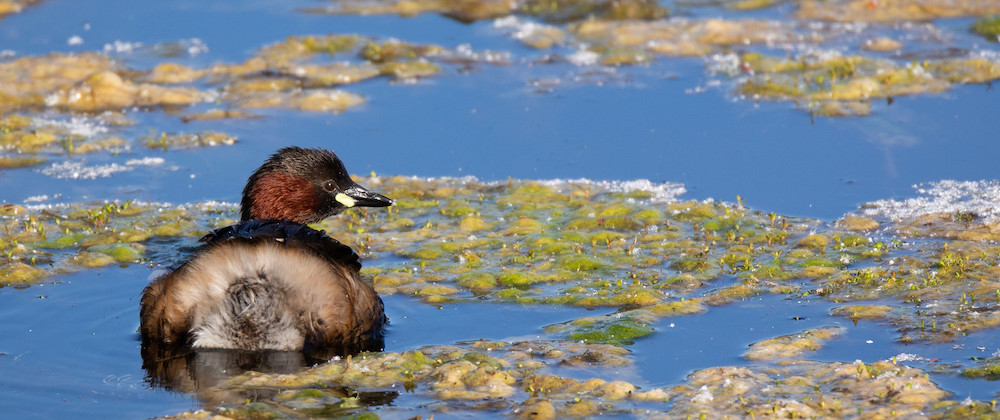61 Boring Birds: #55 Little grebe

My third attempt to find the little owls on Hackney Marshes today, an my third failure. Unlike most British owls, little owls can be very active during the day, so it’s pot luck whether they are in residency at their usual roost spots.
Never mind. Onwards to the adequately consoling Waterworks reserve. This time, since the gloomier weather means the meadow and river were devoid of impromptu festivaling locked down peoples, I stopped off to look for the owl from across the river. The change of perspective made no difference, but I did get good views of a female kestrel hovering overhead.
There is an ongoing battle to save the waterworks meadow from the evil machinations of the Lea Valley Regional Park Authority. “Evil machinations”, may seem an extreme formulation, but considering they are supposed to be custodians of the land for the benefit of local people and wildlife, some of their behaviour is surprising to say the least. An attempt to licence a festival on the site this summer was rebuffed by a local campaign, who are now trying to get the meadow (which used to be a golf course) kept wild. There’s a crowdfunded campaign to gather evidence on the ecological importance of the site. Anecdotally, a number of far from common species use the site. The presence of kestrels — on the amber list of birds of conservation concern — is another small weight in favour of wilding added to the scales.
While the meadow’s position is precarious, the waterworks reserve next door is less so. A few people pick blackberries which, strictly speaking, should be left for the birds but, I confess, I have done so in the past too. I wonder how much of an impact London’s foraging masses have on the availability of food for the birds? I know there are concerns in Epping Forest about the viability of wild fungi populations given the annual decimation of their fruiting bodies by increasing numbers of well-meaning rustic city dwellers just trying to get in touch with nature and avoid supporting the unethical production of food. But it’s complicated, and Hugh Fearnley-Whittingstall has a lot to answer for.
At the ghostly grey slim, dead tree growing out of the corner of the least flooded, most open old filter beds, two magpies remonstrate with a young male green woodpecker who has taken up residence there. This tree is a favourite of the local magpies, and I have counted fifteen or more of them in it on the odd occasion. Centre of the magpie social scene.
The main pools are teeming with young life. A few coots and moorhens of various ages, from the barely hatched to the brink of moving out, are overseen by long-suffering parents. Two immature black-headed gulls float buoyantly upon the water, and step gracelessly through the dense waterweed that gather in dense localised mats.
But best of all are the Little grebe chicks, tended to by surprisingly few parents — I count seven chicks, but only three adults. The youngest of the chicks still have their black and white striped heads, but most are now grown a littel bigger and plainer, and there is just the hint of silver along the back edges of their skulls, making them look like generic characters in a cyberpunk graphic novel.
The chicks are now mainly pretty competent divers, and follow their parents beneath the water for small stretches. But their prowess as fishermen is yet to be proven. They poke their faces in the water, in an effort to find prey, but that’s as far as they take it. They spectate as their parents — non-stop fishing machines — disappear beneath the weeds and once in every few attempts return with a minnow or stickleback or similarly diminutive dish of the day. I watch one of these fish get handed over only to be repeatedly dropped by junior, and subsequently re-fetched from the water by the enduringly patient adult. “Don’t play with your food!” I hear it reprimanding.
Fitting that the meals it puts on its family’s plates are so small because the little grebe is a tiny bird. A couple of tufted duck chicks, less than a week old I would guess, take a dislike to a passing grebe and attack it. They are already bigger than it and the grebe takes the decisive and wise decision to dive out of harm’s way. Better humiliated than hurt.
Resurfacing a few feet away it puffs out its feathers, breaking its slicked-back coat of wet, stuck together wing feathers. Maybe this puffing out is intended to give the illusion of greater size — many animals do similar things both in attack and in defence — but ot mainly succeeds in making it look adorable. With its belgian chocolate coloured neck — milk on the front, dark on the back — little pompodour body and dab of yellow make up at the corner of its beak, “Little grebe” woudl make a charming costume for a small child. Maybe give it a go next halloween.
Leaving the reserve a flock of around twenty, definitely not of conservation concern feral pigeons rise up from the meadow. Though comon as muck, when seen in coordinated flight pigeons can be transformed into shimmering delights.
A peregrine passes by overhead too. I don’t wait around to see if it strikes.
🦅 First boring bird
Related boring birds: Kestrel, Green woodpecker, Magpie, Moorhen, Coot, Black-headed gull, Tufted duck, Feral pigeon, Peregrine
🦚 All boring birds
Yaffle